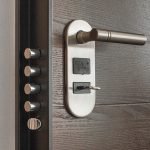
Cutting Yourself While Chopping Vegetables
This is an injury most of us are familiar with. If you do cut your hand in the kitchen, run cold water over your cut, apply pressure with a clean dry bandage and raise your hand above heart level until the bleeding stops. Keep the wound covered and change the bandage daily. You can use an antibacterial ointment to aid healing time and to prevent infection. If the bleeding will not stop or your cut is deep, seek medical attention as soon as possible. Follow the steps below to reduce your risk of a kitchen cutting mishap:
–Only cut on a flat, dry, sturdy surface; ideally a cutting board.
–Cut away from your body, not toward it.
–Chop vegetables with your fingers curled under instead of in the direct line of cutting.
–Do not try to cut frozen foods.
–Do not use knives for things you can use scissors for—like opening a tightly sealed package.
–If you drop your knife accidentally do not try to catch it, instead take a large step backward.
–Sharpen your knives regularly as dull knives cause more injuries.
Burns
Burns are most common while cooking in the kitchen or from the faucet in the bathroom. If you or a 
–Always use real oven mitts when taking things in and out of the oven or when working with a hot pot or pan. Napkins, dishtowels, and aprons are not oven mitts.
–Avoid the temptation to “check” or move things with your fingers. Instead, use kitchen tongs designed for heat.
–When taking the lid off an item that has been on the stove or in the oven, make sure your face and body are not in the direct line of its steam and heat.
–Make sure the handles of your pots, pans, and utensils are not left exposed to heat. If they are, use your oven mitts.
–When frying things in grease use tongs and wear long, but not loose or bulky, sleeved shirts.
–Wait until hot foods have sufficiently cooled prior to serving such as coffee, tea, and soups.
–Install anti-scald devices on the faucets that your young children can reach.
–Reduce the temperature of your water heater to below 120 degrees.
Falls
Falls are the leading cause of fatal home injuries. Most falls happen while in the bathroom where it is wet and slippery. If you fall in the bathroom, carefully get up if you are able. If you feel like it is unsafe to move, call for help or bang on the wall or floor to attract someone’s attention. Call 911 if it is not safe for someone who has fallen to get up independently—don’t hurt yourself attempting to help someone up. Follow the steps below to reduce your risk of a fall in the bathroom:
–Place slip resistant mats inside your bathtub, even if it does not “feel” slippery to you. When soap 
–Place a bathmat with a rubberized bottom outside of your bathtub. This will reduce your chance of slipping by having something absorbent and rubberized to step onto.
–Add grab bars to your bathtub. While this may not be the most attractive addition it is a highly recommended bathroom safety feature.
It is wise to keep a first aid kit in your home so that you are prepared for any in-home injuries that unexpectedly arise. Being properly prepared can be the difference between a minor injury and a major injury.
This article was contributed by Samantha Greenbaum, health nut, marathon runner and weekend backpacker. For those in the Pearland, TX area looking for quick, efficient urgent care, Samantha suggests checking out Prime Urgent Care.






